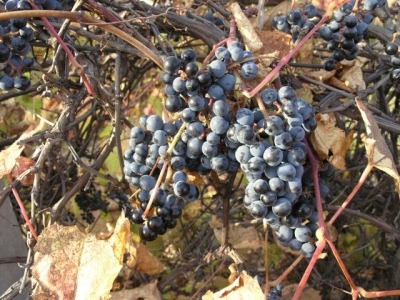
- Authors: A.I. Potapenko, L.P. Potapenko (Nizhne-Volzhsky Research Institute of Agriculture)
- Appointment: technical
- Berry color: black
- Taste: simple
- With bones: Yes
- Ripening period: average
- Frost resistance, ° C: -40
- Bunch weight, g: 170
- Yield: up to 10 kg
- Density of the bunch: medium
Grapes traditionally belong to the southern culture, its ripeness and sugar content depend on the amount of sunlight received during ripening. In severe winters, many grape varieties freeze and require burying of shoots. But lovers of this culture tend to breed it in those places where it did not give good harvests before and did not tolerate the cold season poorly. The variety adapted to the harsh climate is the Amur's Firstborn.
Breeding history
The creation of a new variety is based on the Amur variety and other winter-hardy varieties of wild grapes. The work on its selection was carried out in 1983-86 by the Potapenko family of scientists. Positive results were obtained by these breeders at the Nizhnevolzhsk Agricultural Research Institute, and in 1991 the test of the culture began. The main region for growing the Pervenets Amura variety is the North Caucasus, but it is successfully bred in more northern regions.
Description
The grape bushes grow vigorous, with a strong vine, and are particularly resistant to significant frost temperatures. The firstborn of the Amur belongs to the species with an average ripening period of berries. The leaves are three-lobed, slightly pubescent on the underside, at the beginning of the season they have a reddish tint, which then becomes dense green. The characteristic wine variety produces small, dense clusters that are ready for harvest at the end of September. Black, medium-sized berries have a slightly elongated shape.
Ripening period
A mid-season variety begins to bloom in late May - early June, and by the end of the first autumn month it reaches technical ripeness and is ready for harvesting.
Bunches
On strong liana-shaped shoots, medium-sized conical clusters grow, which can weigh 170-200 grams.
Berries
The grapes are relatively small, shiny, black, for technical purposes. The berries are round, slightly elongated and contain small seeds.
Taste
Grape juice is simple in taste, but the wines made from it have a pleasant aroma and contain many useful substances. Vitamins and antioxidants contained in homemade wine from the Firstborn Cupid help lower blood cholesterol and maintain normal blood pressure levels. There are many organic acids in the fruit juice of the plant, including citric, malic and succinic. It also contains a large amount of minerals - iron, potassium, cobalt and calcium.
Treatment with fresh grapes and processed juice from its fruits is successfully used for diseases of asthma, urinary tract, as well as disorders of digestive processes and appetite.
Yield
Erect or curly vines of the Firstborn Cupid are distinguished by high productivity. On vigorous shoots, many clusters are formed, and the leaves are no less rich in phytoncides and are also eaten.


Growing features
Due to its unpretentiousness, the hybrid variety Firstborn of Amur is suitable for novice amateur gardeners, since it does not require special care. Young seedlings tolerate transplanting well and quickly take root in a new place. A vigorous shrub quickly gains mass due to the high rate of shoot formation. In the curly variety, it braids closely adjacent supports at high speed. Within only one year, vines can grow up to 2 meters in length.
Landing
The holes for planting grape seedlings are usually prepared 60x60 cm in size. A layer of humus is placed in them, 200 grams of ash and sour peat each, since the plant prefers a loose type of soil with a sour reaction. Cuttings take root well when planted after harvest, at the end of September. It is not recommended to plant grapes of the Firstborn Cupid near trees. For him, sunny and protected from the north wind areas are suitable. This can be the south side of the house or solid fences, as well as the south slopes in rugged terrain.

Pollination
The Grape Firstborn of the Amur belongs to self-pollinated plant species and does not need to be planted with additional pollinating varieties.
Pruning
Pruning of the plant and removal of damping shoots is carried out in the spring, when severe frosts recede, but active sap flow in the branches has not yet begun. Leave 3 buds on young shoots and remove dry, damaged and heavily thickened areas. Places of large cuts on the trunk must be treated with garden pitch.



Frost resistance and the need for shelter
The further north the region where the Amur variety is grown, the better the gardeners' reviews about it. This is due to the fact that grapes tolerate a warm winter worse than frosts down to -40 degrees. Moreover, it does not require shelter, except for the first year, when the root system is still weak.

Diseases and pests
At the beginning of the spring season, it is useful to treat the grapes with a solution of lime with the addition of copper sulfate. This not only protects the plant from typical diseases, but also feeds it with calcium through the bark. In general, the hybrid is resistant to many common diseases of this culture.

If a grape is exposed to any disease or insect, this always affects its appearance.
Storage
The harvested bunches of grapes are usually not stored for a long time and are immediately sent for processing. Vitamin juices or compotes are prepared from them, with added sugar, and they are also preserved in the form of wine drinks, which in moderation are very beneficial to health.











































































